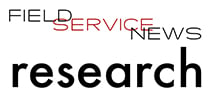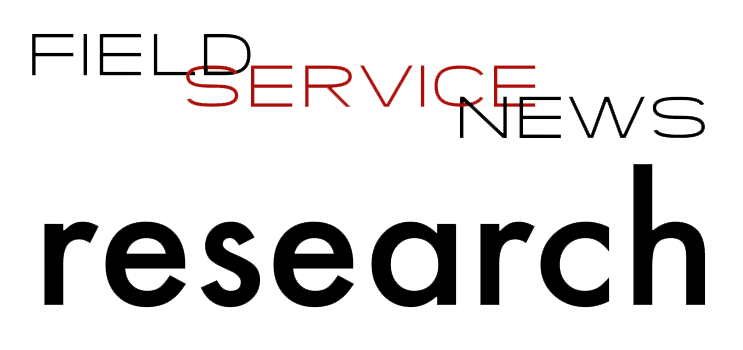Digital Transformation meets the acceleration of global disruption
Perhaps the most overt and also important outcome of the pandemic is that the digital transformation journey our industry has been on for some time now has been massively accelerated by the pandemic. Not only have many companies taken quantum leaps forwards in their own digitalisation programs, but even more critically we have established a new understanding of what is possible in terms of how quickly such projects can effectively be implemented...
Having undertaken an extensive research project with FieldAware in the latter months of 2020 we released a ground-breaking report that identified the emerging trends of the new normal. Having assessed the sectors opinions at the time we then returned to interview a selection of the respondents to go Beyond the Data and leverage deeper insight.
The following article is an excerpt from a report based upon those interviews as well as our exclusive debrief session.
As we come to the end of this second report within this study, which was a ground-breaking piece of research that captured the Zeitgeist of a global industry in the midst of seismic disruption, the final area of focus is perhaps the one that each of us working within field service management would have likely predicted to see emerge as a trend within the study.
That is of course, that the digital transformation that was already happening at significant pace prior to the pandemic has been put on turbo boosters and is set for the moon.
The study revealed that two thirds of fields service companies were already in the process of undergoing some aspect of digital transformation. Yet, of that group 67% of field service companies stated that these plans had been accelerated by the pandemic.
“We were on a digital transformation plan already, but how quickly that progressed and where the priorities were for various elements has undoubtedly been accelerated,” commented one respondent an innovation program manager for a German company working with the print management sector.
“Plans that we have had in place across a three and even five-year program have been condensed into six months,” said another respondent, a US based head of technical service for a global industrial manufacturer working across multiple sectors.
“In one sense, from a purely operation point of view, the pandemic drove a lot of the change we had been looking to implement for some time, but had trouble getting that final buy-in from the exec board as their view prior to the pandemic was this was a dot on the horizon that we would work towards but there was no urgency. The pandemic introduced that urgency,” said another respondent, who was Head of Service EMEA for a Dutch manufacturer.
“We were on a path towards improving our service operation. That path involved remote services, it involved better use of data, it involved servitization. We had it all fairly well planned. Now we’ve just got to work a lot harder in the short term to make it all happen a lot quicker. We’ve had to in a degree cut corners to get where we are, but we had no choice, we had to get here...”
For Tatarsky, in many ways the fact that the seeds were already planted gave us the tools we needed to adapt.
“I think as an industry we have been reasonably fortunate in that a lot of what we needed to make it through, to change and innovate, much of the foundations had been in place for a while. This has meant that it has been a matter of accelerating adoption rather than completely changing the way we work.
“It has been fortunate that we haven’t had to completely start from scratch on some of these technologies. We have been able to act on many of the seeds that had already been planted, embrace many of the ideas that have been talked about for some time.
“As a sector it’s been important in terms of our ability to adapt that we were all coming from a consistent knowledge base and had that shared understanding of what it takes to achieve the changes we needed to put in place and the concepts of how to utilize those.
“The challenge is that while committing to adapting is the first step, being able to have the infrastructure to take on some of the new technologies and then be able to change your processes to take advantage of that new technology is still a heavy lift.
“There’s a lot of work to be done in our industry, to be able to start fully taking advantage of these technologies.
“What we do have though, is a path forward, and a path that allows us to be able to address many of the challenges that a pandemic like this has created.
“However, I don’t want to understate the challenge associated with getting to that future state. What we’ve really done is jump start the maturity process and while you can accelerate that, it is still a process you have to go through from a technology adoption standpoint, from a data understanding and from an adoption standpoint and then a process transformation standpoint. On top of this there are then work processes changes which need to take place as well. Those things take time, and they take investments.
“With regards to digital transformation almost every service provider is at a different level of maturity. Some service providers are in the early stages of just getting to field service automation and beginning to digitize the basic elements of field service delivery, others are in more advanced stages of the journey.
“What is critical is to have the underpinnings of a system that can support that growth and evolution,” Tatarsky adds.
Indeed, the pandemic has brought hardship and accelerated innovation in equal measure. Now we face an entirely new set of challenges, the growing pains of an industry hitting a new period of maturity perhaps?
Having undertaken extensive interviews to help shape this final report in the study, it is fitting that a quote from one of those interviews leaves us with an excellent summary of the situation we find ourselves in today.
“We were on a path towards improving our service operation. That path involved remote services, it involved better use of data, it involved servitization. We had it all fairly well planned. Now we’ve just got to work a lot harder in the short term to make it all happen a lot quicker. We’ve had to in a degree cut corners to get where we are, but we had no choice, we had to get here.
“Now as the dust settles a little bit, we are refining things, processes, ideas, technology use, bit by bit. It’s been a tough twelve months, I’m not going to lie, and there is a lot of work still ahead of us, but ultimately, all after all that hardship, after all that effort, we will be in an infinitely better position as a company, and I’d say probably as an industry as well.”
 If you are a Field Service News subscriber on either our FSN Standard free forever tier or our FSN Premium or FSN Elite subscription tiers you can access a 16 page report written by Field Service News, Editor-in-Chief, Kris Oldland that offers in-depth analysis of the final wave of interviews within this study now on the button below. If you are on the FSN Standard subscription tier this will only be available for a limited period.
If you are a Field Service News subscriber on either our FSN Standard free forever tier or our FSN Premium or FSN Elite subscription tiers you can access a 16 page report written by Field Service News, Editor-in-Chief, Kris Oldland that offers in-depth analysis of the final wave of interviews within this study now on the button below. If you are on the FSN Standard subscription tier this will only be available for a limited period.
If you are not yet a subscriber to Field Service News but would like to subscribe and gain access to this report instantly, click the button to be visit a dedicated registration page for our complimentary sponsored subscription tier FSN Standard and that will give you instant access to this paper and a selection of other assets currently available to subscribers on this tier.
 Data usage note: By accessing this content you consent to the contact details submitted when you registered as a subscriber to fieldservicenews.com to be shared with the listed sponsor of this premium content, FieldAware who may contact you for legitimate business reasons to discuss the content of this report.
Data usage note: By accessing this content you consent to the contact details submitted when you registered as a subscriber to fieldservicenews.com to be shared with the listed sponsor of this premium content, FieldAware who may contact you for legitimate business reasons to discuss the content of this report.
Written by Kris Oldland
Kris Oldland has been working in Business to Business Publishing for almost a decade. As a journalist he has covered a diverse range of industries from Fire Juggling through to Terrorism Insurance. Prior to this he was a Quality Services Manager with a globally recognised hospitality brand. An intimate understanding of what is important when it comes to Service and a passion for emerging technology means that in Field Service he has found an industry that excites him everyday.


